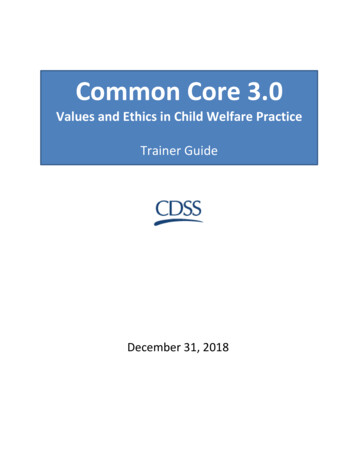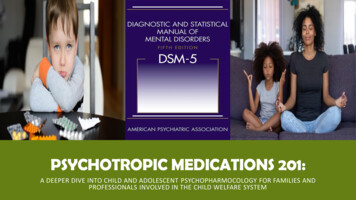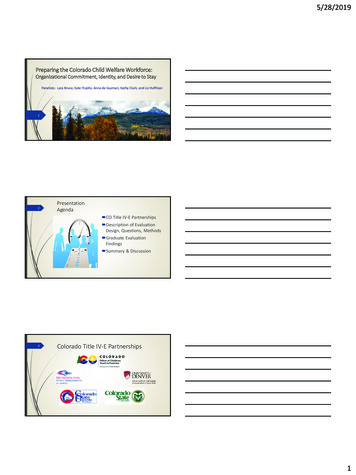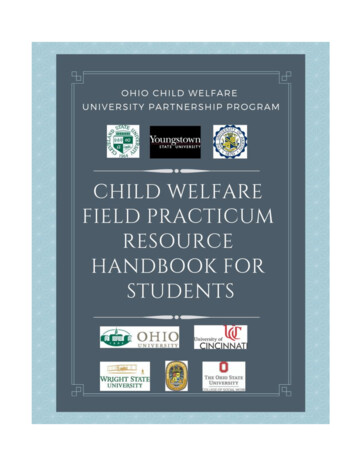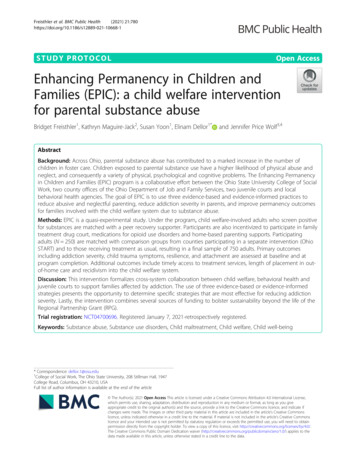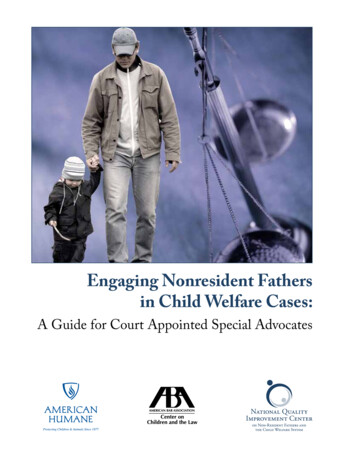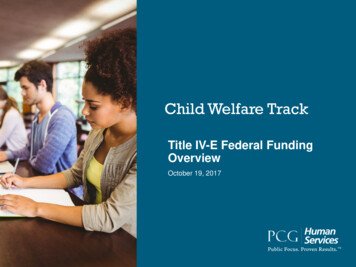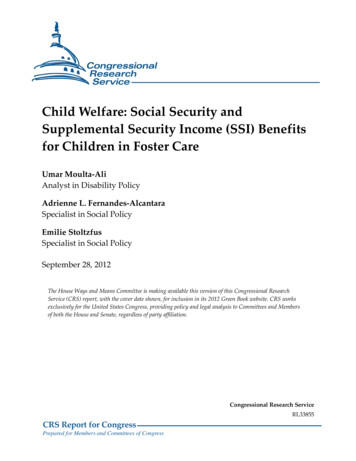
Transcription
Child Welfare: Social Security andSupplemental Security Income (SSI) Benefitsfor Children in Foster CareUmar Moulta-AliAnalyst in Disability PolicyAdrienne L. Fernandes-AlcantaraSpecialist in Social PolicyEmilie StoltzfusSpecialist in Social PolicySeptember 28, 2012The House Ways and Means Committee is making available this version of this Congressional ResearchService (CRS) report, with the cover date shown, for inclusion in its 2012 Green Book website. CRS worksexclusively for the United States Congress, providing policy and legal analysis to Committees and Membersof both the House and Senate, regardless of party affiliation.Congressional Research ServiceRL33855CRS Report for CongressPrepared for Members and Committees of Congress
Child Welfare: Social Security and SSI Benefits for Children in Foster CareSummaryOf the more than 400,000 children in foster care on a given day, as many as 24,000 (about 6%)receive Supplemental Security Income (SSI) or other Social Security benefits. Some researchsuggests that a greater number of children in foster care might be eligible for SSI benefits if thisassistance was sought. SSI benefits are available under Title XVI of the Social Security Act forcertain disabled children from families with low incomes and minimal assets. Other SocialSecurity benefits may be paid under Title II of the act to the children of workers who have retired,become disabled, or died.Federal regulations require that in most cases the Social Security Administration (SSA) select andassign a representative payee—an individual, organization, or government entity—that managesSSI and Social Security payments for children, including those in foster care. Nearly all statesdesignated as the representative payee for a foster child use the child’s benefits to support thechild in foster care. In Washington State Department of Social and Health Services v.Guardianship Estate of Keffeler (hereinafter Keffeler), the Supreme Court held that the processused by the state of Washington to keep the Social Security benefits received as a child’srepresentative payee was not prohibited by the Social Security Act. The Court also concluded thatthe use of funds for reimbursement for foster care services was consistent with the act’sprovisions that such funds be spent for the “use and benefit of the beneficiary” and within theregulatory definition of “current maintenance” (i.e., food, clothing, shelter, medical care, andpersonal comfort items).Although the Keffeler decision supports states’ practice of using SSI and other Social Securitybenefits for reimbursement of foster care, some child advocates assert that by using these benefitsto reimburse the cost of foster care, the state agency denies the child beneficiaries funding thatrightly belongs to them. Advocates also raise concern that child welfare agencies are oftenautomatically assigned as the representative payee for foster children. On the other hand, childwelfare agencies and advocates argue that if states were not able to use benefits to pay for achild’s foster care, they would stop screening children to determine their eligibility for theseSocial Security programs. They further raise the concern that if a foster child’s SSI benefits wereallowed to accumulate in a savings account, the child would soon surpass the “means test” forSSI and would lose eligibility for the benefits.Changes governing how child welfare agencies are assigned as representative payees or how theyuse the Social Security benefits of foster children would require congressional action. Forexample, Congress could permit or require states that act as representative payees to “passthrough” some or all benefits to eligible foster children and those children could receive a portionof the benefits while in care and/or upon leaving care. Congress could also make changes to theselection of representative payees so that certain individuals, such as the child’s attorney, wouldhave the opportunity to serve as the payee.Legislation has been introduced that would prohibit using SSI or Title II Social Security benefitsto reimburse a state for foster care maintenance payments; require state child welfare agencies toscreen foster children for benefits; and for any foster child already receiving benefits, it wouldalso require the state to develop a plan to “conserve benefits not necessary for the immediateneeds of the child” to enable the child to “achieve self-support after leaving foster care.”Congressional Research Service
Child Welfare: Social Security and SSI Benefits for Children in Foster CareContentsIntroduction . 1Overview of Foster Care . 2Federal Requirements Applicable to All Foster Care Children . 2Title IV-E Federal Foster Care Program. 2Foster Care Maintenance Payment . 3Other Reimbursable Costs . 4Support for Foster Children Not Eligible for Title IV-E . 4Youth Who “Age Out” of Foster Care . 5Social Security and Supplemental Security Income (SSI) Benefits for Children. 6Social Security Benefits for Children (Title II) . 7Benefit Amounts for Children . 7When Children’s Benefits Stop . 7SSI Benefits for Children (Title XVI) . 8Benefit Amounts for Children . 8Dedicated Accounts for Children . 9When Children’s Benefits Stop . 10Representative Payees in the Social Security System . 10Representative Payees for Children Receiving Benefits . 10Order of Selection of Representative Payees .11Responsibilities of Representative Payees . 12Statutory Responsibilities . 12Regulatory Responsibilities . 13Special Rules Concerning Creditors and Debts . 13Children in Foster Care Receiving or Potentially Eligible for SSI . 13Concurrent Receipt of Benefits . 15Use of SSI and Other Social Security Benefits by Child Welfare Agencies . 17Keffeler Decision . 19The Decision of the Washington State Supreme Court . 19The Opinion of the Supreme Court . 20Should SSI and Other Social Security Benefits Be Used to Pay for Foster Care? . 21Benefits Should Not Be Used for Foster Care . 21Benefits Should Be Used for Foster Care . 23Possible Legislative Changes . 24Screening Children in Foster Care . 24Passing Through Benefits. 25Temporary Assistance for Needy Families (TANF) . 26Child Support Enforcement . 26Identifying Alternative Representative Payees . 28Changing Asset Levels . 29Plans for Achieving Self-Support (PASS). 30Individual Development Accounts (IDAs) . 30Assisting Youth “Aging Out” Apply for SSI . 31Congressional Research Service
Child Welfare: Social Security and SSI Benefits for Children in Foster CareTablesTable 1. All Children Receiving Social Security and SSI Benefits, July 2012. 7Table 2. Types of Representative Payees for Children in the SSI Program, December2011 .11Table 3. Social Security (SSI and Title II) Benefits as Funding Stream for Child WelfareSpending, SFY2006 . 18ContactsAuthor Contact Information . Error! Bookmark not defined.Congressional Research Service
Child Welfare: Social Security and SSI Benefits for Children in Foster CareIntroductionOn any given day, more than 400,000 children are in foster care due to incidents of abuse,neglect, or other reasons that prevented them from remaining with their parents.1 Of thesechildren and youth, some 6% received Supplemental Security Income (SSI) under Title XVI ofthe Social Security Act or another Social Security benefit (e.g., Survivors benefits) under Title IIof that act. Among the 28,000 youth who were discharged from foster care during FY2010because of their age rather than because of placement in a permanent family (i.e., they “aged out”or were “emancipated”), some 9.5% (2,700) were receiving SSI or Survivors benefits at the timeof their exit from care.2The Social Security Administration (SSA) may designate a government entity as therepresentative payee of a foster child if the child’s custodial or non-custodial parents, guardians,relatives, stepparents, or a close friend are not available to serve in that role. As the representativepayee, the state (like any other representative payee) is required to manage the child’s benefitsand to use the benefits for the current maintenance (food, clothing, shelter, medical care, andpersonal comfort items) of the child. Nearly all states use SSI and/or other Social Securitybenefits to pay for foster care. Thirty-eight states and the District of Columbia reported on theiruse of these benefits in state FY2006, and these benefits totaled 156.6 million.3In recent years, some child welfare advocates have legally challenged the practice of using fosterchildren’s SSI and other Social Security benefits to reimburse states for the cost of providing theirfoster care. The most prominent case, Washington State Department of Social and Health Servicesv. Guardianship Estate of Keffeler, reached the U.S. Supreme Court, which, in 2003, upheld thispractice.4 Nonetheless, the Keffeler decision raised questions about the federal government’s rolein regulating the use of Social Security and SSI payments to fund foster care, and some advocatesremain concerned about the use of these benefits.This report begins with a discussion of the foster care system and the Social Security benefitsavailable to eligible children, including those in foster care. It then describes the role of1U.S. Department of Health and Human Services, Administration for Children and Families, The AFCARS Report#19, Preliminary Estimates for FY2011, July 2012, echnology/statistics-research/afcars. (Hereinafter U.S. Department of Health and Human Services, Adoption and Foster CareAnalysis Reporting System (AFCARS) Report #19.).2Estimate based on the Congressional Research Service’s (CRS) analysis of data reported by 52 jurisdictions (50states, District of Columbia, and Puerto Rico) for FY2010 to the U.S. Department of Health and Human Services(HHS) via the Adoption and Foster Care Analysis Reporting System (AFCARS, FC2010v.1).3Kerry DeVooght, Tiffany Allen, and Rob Geen, Federal, State, and Local Spending to Address Child Abuse andNeglect in SFY 2006, Child Trends, December 2008, p. 19, at http://www.childtrends.org/Files//Child Trends2009 02 17 FR CWFinancePaper.pdf. State-level data were provided by Child Trends to the Congressional ResearchService, January 2009. (Hereinafter Kerry DeVooght, Tiffany Allen, and Rob Geen, Federal, State, and LocalSpending to Address Child Abuse and Neglect in SFY 2006, Child Trends, December 2008.) More recent data on statechild welfare spending does not disaggregate SSI and other Social Security benefits from certain other federal fundingsources for child welfare, including child support, Social Security Disability Insurance (SSDI), and funding from theVeteran’s Administration. See Kerry DeVooght et al., Federal, State, and Local Spending to Address Child Abuse andNeglect in SFY 2008 and 2010, Child Trends, June 2012, http://www.childtrends.org/Files//Child Trends2012 06 20 FR CaseyCWFinancing.pdf. (Hereinafter Kerry DeVooght, et al., Federal, State, and Local Spending toAddress Child Abuse and Neglect in SFY 2008 and 2010, Child Trends, June 2012.)4Washington State Department of Social and Health Services v. Guardianship Estate of Danny Keffeler (Hereinafter,Keffeler, 537 U.S. 371 (2003)).Congressional Research Service1
Child Welfare: Social Security and SSI Benefits for Children in Foster Carerepresentative payees and their responsibilities. The report provides data on the use of SocialSecurity benefits to reimburse states for child welfare, and includes a discussion of the Keffelerdecision. Finally, the report concludes with proposals supported by some advocates to change thecurrent practice of using SSI and other Social Security benefits to fund foster care.Overview of Foster CareChildren in foster care are children for whom a state (or tribe) has been given formalresponsibility for a child’s care and placement by a court or by a voluntary placement agreementbetween the state and a child’s parent or legal guardian. Foster care is the round-the-clock care ofa child outside the child’s home and is typically necessary because of neglect or physical abuse ofthe child by his or her parents or, less commonly, due to child behavioral issues that make thehome unsafe for the child. Children who are removed from their homes may be placed in fosterfamily homes, institutions, or group homes by the state child welfare agency. This sectiondiscusses how state child welfare agencies use federal and state dollars to pay for children in care,and how child welfare agencies provide assistance to children likely to emancipate or “age-out”of foster care.Federal Requirements Applicable to All Foster Care ChildrenThe federal government has established certain requirements related to state provision of fostercare that are applicable to all children in foster care. These include that a state has a written caseplan detailing, among other things, where the child is placed and what services are to be providedto ensure that a permanent home is re-established for the child. Further, for each child in fostercare, this plan must be reviewed on a regular basis, including a review by a judge no less oftenthan every 12 months. For many children who enter foster care, returning to their parents is theway permanence is re-established. For some children, however, it is not safe or possible to reunitewith their parents. In those cases states must work to find adoptive parents or legal guardians whocan provide a permanent home and family for these children.Title IV-E Federal Foster Care ProgramTitle IV-E of the Social Security Act authorizes the federal-state foster care program.5 Under thisprogram, a state may seek federal funds for partial reimbursement of the room and board costsneeded to support eligible children who are neglected, abused, or who, for some other reason,cannot remain in their own homes. Funding for the Title IV-E foster care program is appropriatedout of the general treasury and is available on an open-ended entitlement basis. This means thefederal government is obligated to reimburse states for every eligible cost made on behalf of aneligible child.Of the more than 400,000 children in foster care in the United States on any given day of the year,a little less than half of these are estimated to be eligible for federal foster care support under TitleIV-E. To be eligible for Title IV-E, a child in foster care must also (1) meet income/asset tests and5Throughout this report, references to titles, parts, or sections of the law refer to the Social Security Act, unlessotherwise stated.Congressional Research Service2
Child Welfare: Social Security and SSI Benefits for Children in Foster Carefamily structure rules in the home from which he/she was removed;6 (2) have specific judicialdeterminations made related to reasons for the removal and other aspects of his/her removal andplacement; and (3) be placed in an eligible licensed setting with an eligible provider(s).Foster Care Maintenance PaymentThe state child welfare agency is required to use federal Title IV-E funds to provide a “foster caremaintenance payment” to the home or institution where the eligible child is placed to provide fortheir care and safety. Title IV-E defines a “foster care maintenance payment” as “payments tocover the cost of (and the cost of providing) food, clothing, shelter, daily supervision, schoolsupplies, a child’s personal incidentals, liability insurance with respect to a child, reasonabletravel to the child’s home for visitation and reasonable travel for the child to remain in the schoolin which the child is enrolled at the time of placement.”7States are allowed to determine how much the total foster care maintenance payment will be foreach child, and even within states the amounts may vary considerably based on factors like thechild’s age, special needs, or placement setting (e.g., home vs. institution). The portion of eacheligible foster care maintenance payment that is reimbursed by the federal government isdetermined by the state’s Federal Medical Assistance Percentage (FMAP), which may range from50%, in states with the highest per capita income, to a maximum of 83%, in the lowest per capitastates.8 In FY2011, the most recent year for which these data are available, states made foster caremaintenance payments on behalf of an average of 168,385 Title IV-E eligible children eachmonth. Those payments cost about 2.406 billion and states claimed federal reimbursement of 1.169 billion. For FY2011 then, the average monthly maintenance payment cost per eligiblefoster care recipient was about 1,427 and of this amount, the federal government reimbursedstates roughly 829 (about 60% of the total costs).9 This federal share of maintenance payment6With an exception, discussed below, the income and asset tests, as well as family structure/living arrangement rulesare identical to the federal /state rules that applied to the now-defunct cash aid program, Aid to Families withDependent Children (AFDC), as they existed on July 16, 1996. Under the prior law AFDC program, states establishedspecific AFDC income and asset rules (within some federal parameters). The federal AFDC asset limit was 1,000;however, P.L. 106-169 raised the allowable counted asset limit to 10,000 for purposes of determining Title IV-Eeligibility. In addition to meeting the income/asset criteria in the home from which he/she was removed, a child mustmeet the AFDC family structure/living arrangement rules. Those rules granted eligibility primarily to children insingle-parent families (parents are divorced, separated, or never-married and one spouse is not living with the child; orthe parent is dead). In some cases a child in a two-parent family may be eligible (if one parent meets certainunemployment criteria).7Section 475(4)(A) of the act (42 U.S.C. §675(4)(A). Section 8.3B.1 of the Child Welfare Policy Manual of theChildren’s Bureau, Administration for Children, Youth and Families (ACYF), Administration for Children andFamilies (ACF), Department of Health and Human Services (Hereinafter referred to as the Child Welfare PolicyManual) further discusses allowable federal foster care maintenance payment costs and is available athttp://www.acf.hhs.gov/cwpm/programs/cb/laws policies/laws/cwpm/index.jsp.8For more information see CRS Report RL32950, Medicaid: The Federal Medical Assistance Percentage (FMAP), byAlison Mitchell and Evelyne P. Baumrucker.9Based on Title IV-E expenditure claims submitted by states as of May 2012 for FY2011 and as compiled by U.S.Department of Health and Human Services (HHS), Administration for Children and Families (ACF), Office ofLegislative Affairs and Budget (OLAB) and excludes maintenance payment costs reimbursed through child supportcollections. The number of Title IV-E eligible children and the total payment cost and total federal reimbursementincludes data from Florida (statewide) and in two large counties in California (Los Angeles and Alameda). However,under waiver authority those jurisdictions receive Title IV-E funding in a lump sum and so none of their expendituresfor foster care maintenance payments are reported separately or shown here. Therefore, data from those states and fromtwo additional states (Pennsylvania and Idaho) where data were believed unreliable were excluded from the calculationof average monthly maintenance payment cost, per recipient, and share of costs reimbursed by the federal government.(continued.)Congressional Research Service3
Child Welfare: Social Security and SSI Benefits for Children in Foster Carecosts is higher than in previous years (when it stood at about 56%) because states receivedenhanced federal support for foster care maintenance payments under provisions of the AmericanRecovery and Reinvestment Act (P.L. 111-5, as amended by P.L. 111-226) for a part of FY2011.10Other Reimbursable CostsIn addition to the maintenance payment, the Title IV-E foster care program reimburses othereligible costs that are related to case management and child placement services, and other fostercare program administrative costs, including development and operation of a system for statewidechild welfare data collection. In most instances, administrative claims may only be made withregard to costs incurred on behalf of Title IV-E eligible children.11 In FY2011, states spent 4.075billion for these broadly defined Title IV-E foster care “administrative” costs and received federalreimbursement for one-half ( 2.038 billion) of these costs. States are also permitted to claimsome reimbursement for training costs related to provision of foster care (so long as they aremade on behalf of eligible children). For FY2011, states made claims of 269 million and thefederal share of Title IV-E claims for those purposes was about 201 million. Finally, a number ofstates receive Title IV-E support under special waiver authority that enables them to use the fundsfor a broader range of child welfare purposes than would otherwise be possible under the Title IVE foster care program. For FY2011, 683 million in federal Title IV-E foster care funding wasdistributed to certain states under child welfare waiver demonstration authority.12Support for Foster Children Not Eligible for Title IV-EBetween one-fifth and one-quarter of a million children in foster care—that is, children removedfrom their homes and given over to the care and placement responsibility of the state—do notmeet the federal Title IV-E eligibility criteria. The federal government does not explicitly requirethat a state make a foster care maintenance payment on behalf of these children. Practicallyspeaking, however, placing such a child in an out-of-home setting without providing somereimbursement for the cost of that child is difficult, and in many circumstances might beconsidered a questionable exercise of the state’s responsibility for the child. Accordingly, allstates are believed to provide payments on behalf of children who are placed out of the home andunder the responsibility of the state, regardless of the child’s Title IV-E eligibility status.(However, some states do pay lesser amounts to relatives who provide foster care for non-Title(.continued).10In FY2009, FY2010, and the first quarter of FY2011, the American Recovery and Reinvestment Act (P.L. 111-5)increased the annually calculated FMAP rate for Title IV-E purposes by 6.2 percentage points in all states (i.e., no statehad an FMAP of less than 56.2%). Under the popularly titled Education, Jobs and Medicaid funding bill (P.L. 111226), Congress extended this enhanced support for six months. However, the level of additional support provided waslowered during this time to an additional 3.2 percentage points for the second quarter of FY2011 and to 1.2 percentagepoints during the third quarter of FY2011.11Claims for costs related to specified data collection purposes and for eligibility determination may be made withoutregard to Title IV-E eligibility status of children.12Based on state Title IV-E foster care claims submitted for FY2009 as compiled by HHS, ACF, OLAB in May 2012.The large majority of this funding, 90% was distributed to two states (California: 461 million and Florida: 156million.).Congressional Research Service4
Child Welfare: Social Security and SSI Benefits for Children in Foster CareIV-E eligible children.)13 In general, maintenance payments to support foster children who are notTitle IV-E eligible must be supplied by the state (or local) government.To offset the administrative costs (costs related to case management and child placement services,training, data collection, and other administrative costs) of providing foster care to children noteligible under Title IV-E, states may use federal funding provided under the Title IV-B StephanieTubbs Jones Child Welfare Services program (which received 281 million in FY2012 funding).However, these costs for children in foster care who are not federally eligible are largely paidwith non-federal (state or local) dollars, as well as some dollars from federal funding streams notsolely dedicated to child welfare purposes. These include the Temporary Assistance to NeedyFamilies (TANF) block grant, the Social Services Block Grant (SSBG), and Medicaid.14Youth Who “Age Out” of Foster CareDespite the effort to find a permanent home for all foster children, some children reach the age ofmajority (18 years of age in most states) and thus “age-out” of foster care before a new permanenthome is found for them. An estimated 26,286 children “aged-out” of foster care during FY2011.15In general, federal Title IV-E funding has generally been available for foster care youth until their18th birthday.16 However, beginning with FY2011, states have the option to seek federalreimbursement for the cost of providing foster care to eligible youth until age 19, 20, or 21—whichever age the state selects.17 The youth must meet certain criteria to stay in care. They mustbe completing high school or a program leading to an equivalent credential; enrolled in aninstitution that provides post-secondary or vocational education; participating in a program oractivity designed to promote, or remove barriers to, employment; or employed at least 80 hoursper month (i.e., part-time). States may also seek reimbursement for an older youth’s foster care ifthe youth has a medical condition that makes him or her incapable of participating in the activity,and this incapacity is supported by regularly updated information in the youth’s case plan.States that wish to extend care must still provide services to help foster youth make the transitionto independent adulthood, and they currently receive some funds (through the Chafee Foster CareIndependence Program and a related Education and Training Vouchers program, combined13Under a 1979 U.S. Supreme Court ruling in Miller v. Youakim (444 U.S. 125 (1979)), states are not permitted tomake a lesser foster care maintenance payment on behalf of a Title IV-E eligible child placed with a relative than thestate would pay for that same child if he/she were placed with a non-relative. This rule, however, does not apply withregard to foster care children who are not eligible for Title IV-E foster care support. Under the Temporary Assistancefor Needy Families (TANF) block grant, states may
child's foster care, they would stop screening children to determine their eligibility for these Social Security programs. They further raise the concern that if a foster child's SSI benefits were allowed to accumulate in a savings account, the child would soon surpass the "means test" for SSI and would lose eligibility for the benefits.
